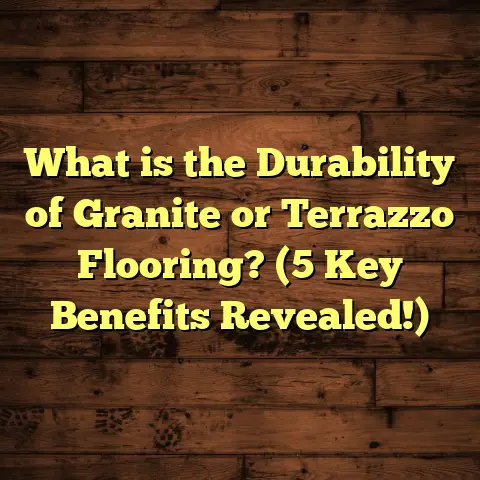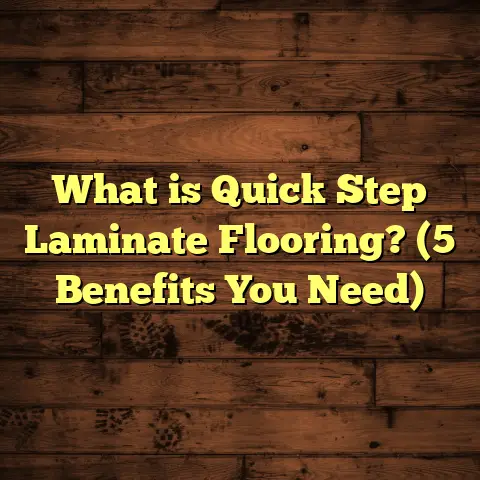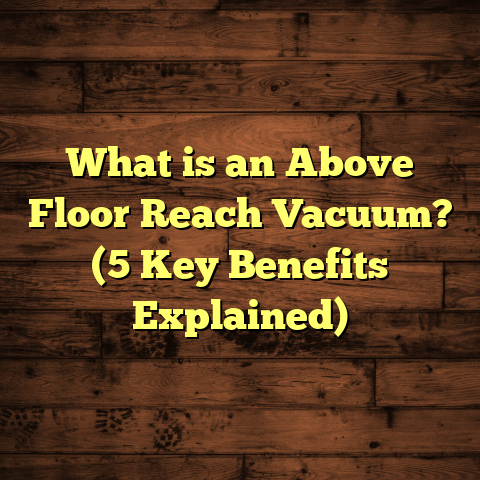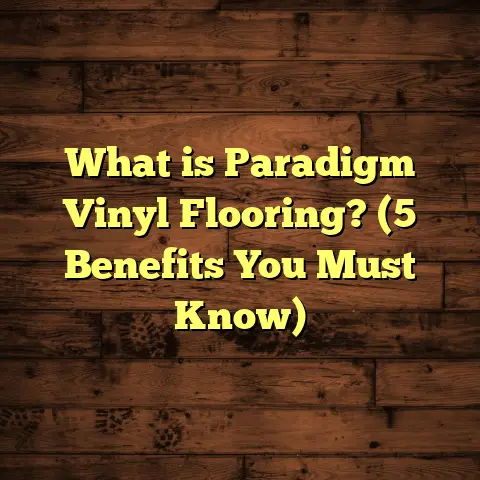What is Hardwood Floor? (5 Essential Benefits You Must Know)
Have you ever stepped into a room and immediately noticed something about the floor that made the whole space feel inviting? That feeling of warmth, character, and natural beauty often comes from hardwood floors. When I installed hardwood flooring in my own home years ago, I was amazed at how it transformed not just the look but the entire atmosphere. It wasn’t just about adding a surface to walk on — it was about bringing life and personality into the space. But what exactly is hardwood flooring? What makes it stand out from other options? Let me walk you through everything I’ve learned as a flooring contractor and homeowner — from the basic concepts to some insider details you might not expect.
What Is Hardwood Floor?
Hardwood flooring refers to flooring made from solid wood planks cut directly from trees. These planks are typically crafted from hardwood species such as oak, maple, cherry, walnut, or hickory. Unlike laminate or vinyl flooring, which only mimic the look of wood through printed layers or thin veneers, hardwood is made entirely of natural wood.
Solid Hardwood vs. Engineered Hardwood
There are two main types of hardwood flooring:
- Solid Hardwood: Planks milled from a single piece of wood, usually ¾ inch thick.
- Engineered Hardwood: Composed of a thin layer of hardwood on top of plywood or high-density fiberboard.
Solid hardwood is prized for its durability and ability to be sanded and refinished multiple times over decades. Engineered hardwood offers better moisture resistance and is often preferred in areas like basements or kitchens where humidity fluctuates.
Why Choose Hardwood?
Unlike carpet or synthetic floors, hardwood has an authenticity that synthetic materials can’t replicate. Each plank features unique grain patterns, knots, and color variations that tell a story of the tree it came from. This natural variation means your floor will have character that no two homes share.
I still recall a client who was initially torn between laminate and hardwood. After I explained how hardwood ages beautifully over time and can be refinished when damaged, they chose solid oak. Years later, they told me their floors felt like part of their family’s history — something they could pass down.
The History and Evolution of Hardwood Flooring
Hardwood floors have been around for centuries. Early American colonial homes used wide plank pine or oak floors that were both functional and beautiful. Over time, flooring manufacturers refined milling techniques to create narrower planks with tongue-and-groove edges for easier installation.
In the 20th century, engineered hardwood emerged as a popular alternative offering stability in climates where solid wood might warp. Today, advances in finishing technologies allow prefinished hardwood to be installed faster with durable coatings.
Knowing this history helps me appreciate why hardwood remains a go-to choice: it blends tradition with modern innovation.
5 Essential Benefits of Hardwood Floors You Must Know
1. Timeless Beauty and Unique Character
Hardwood floors have a visual appeal unlike any other material. Because each plank is natural wood, no two floors are exactly alike.
- The grain patterns vary widely depending on species and cut.
- Natural knots and color changes add depth.
- Wood tones range from soft blondes to rich reds and dark browns.
For example, white oak has a beautiful neutral tone with subtle grain, while walnut offers deep chocolate hues with dramatic swirls.
I’ve worked on installations where clients spent hours choosing between species because they wanted just the right look to complement their furniture and paint colors. Once installed, many say the floors become the “heart” of their home.
Data Insight: Species Popularity
According to the National Wood Flooring Association (NWFA), oak remains the most popular hardwood species in North America, making up about 70% of installations. Maple and hickory are growing in popularity due to their hardness and unique grain patterns.
2. Durability That Lasts Generations
One of hardwood’s biggest advantages is its long lifespan. Solid hardwood floors can last 50 to 100 years if cared for properly. How? Because you can sand and refinish them multiple times.
Think about it this way: when your floor gets scratched or worn after years of foot traffic, rather than replacing it entirely like carpet or laminate, you simply sand away the top layer to reveal fresh wood beneath and apply new finish coats.
I once refinished floors in a 120-year-old farmhouse. The original wide pine planks were worn but structurally sound. After sanding off over a century of wear and refinishing with modern UV-cured finishes, the floors looked stunning—like new but full of character.
Statistics on Longevity
- NWFA states solid hardwood can typically be sanded 7-10 times.
- Homes with hardwood floors sell faster; real estate studies show they can increase home value by 2-3%.
- A study by Zillow found homes with hardwood floors sold 6 days faster on average than those without.
3. Healthier Indoor Air Quality
You might not immediately think of flooring as a factor in air quality, but it matters a lot. Carpets trap dust mites, allergens, pet dander, and mold spores in their fibers—something that can worsen allergies or asthma.
Hardwood floors are easy to clean thoroughly by sweeping or vacuuming regularly. This means fewer allergens circulating in your home’s air.
A client with severe allergies told me switching from carpet to hardwood drastically reduced her symptoms during spring pollen season. It’s one of those quality-of-life improvements that often goes unnoticed until you experience it yourself.
4. Versatility in Design and Finish Options
Hardwood offers endless possibilities for customization:
- Species choice (oak, maple, cherry, walnut, etc.)
- Plank width (from narrow strips to wide planks over 7 inches)
- Stain colors (natural clear finish to dark espresso or gray)
- Surface textures (smooth, hand-scraped, wire-brushed)
- Finish sheens (matte, satin, semi-gloss, glossy)
This variety lets you match virtually any interior style—from rustic cabins to contemporary lofts.
I remember installing smooth walnut floors with a matte finish in a minimalist apartment that contrasted beautifully with bright white walls—clean and modern yet warm underfoot.
Trend Note: Wide Planks Are Popular
Recently, wider planks (5-7 inches) have made a big comeback for their ability to make rooms feel larger and show off more wood grain detail.
5. Long-Term Cost Efficiency
At first glance, hardwood floors can seem expensive compared to carpet or vinyl—especially solid hardwood. But when you factor in lifespan and maintenance costs over time, hardwood often ends up being more cost-effective.
Carpet generally needs replacing every 7-10 years due to wear or stains. Vinyl might last 10-15 years but doesn’t add resale value.
With hardwood:
- A floor can last decades.
- Refinishing costs are usually less than replacement.
- Increased home value can offset initial investment.
When I plan projects now, I rely on tools like FloorTally to break down all these costs precisely. It uses local labor rates and material pricing so I can create an accurate budget for clients that includes installation complexity and waste factors.
FloorTally saves me hours compared to manually gathering quotes from suppliers and installers. It helps avoid surprises by including things like underlayment costs, stain or finish options, and removal of old flooring.
Installation Process: What You Should Expect
Installing hardwood flooring isn’t just laying down wood planks—it requires careful preparation and skillful execution to ensure longevity and performance.
Subfloor Preparation
Before installation begins:
- The subfloor must be clean and structurally sound.
- Any unevenness needs leveling.
- Moisture levels must be checked because wood expands/contracts with humidity changes.
I’ve seen jobs delayed because moisture tests weren’t done properly upfront—leading to warping later on.
Acclimation Period
Hardwood needs time to acclimate to your home’s environment before installation—usually between 3-7 days depending on climate.
This process balances moisture content between wood and room humidity so planks don’t shrink or swell excessively after installation.
Installation Methods
Depending on the type of hardwood and subfloor material:
- Nail-down is common for solid hardwood on wooden subfloors.
- Glue-down works well for engineered hardwood on concrete slabs.
- Floating involves attaching planks to each other but not the subfloor—typical for engineered products over various surfaces.
Choosing the right method affects durability and noise levels post-installation.
Finishing Options
Solid hardwood often comes unfinished so you can choose custom stains onsite. Prefinished options arrive factory-coated with durable finishes like aluminum oxide for faster installation with less mess.
I usually recommend prefinished for ease unless clients want very specific stain colors or textures requiring onsite finishing.
Personal Stories From My Hardwood Flooring Projects
Let me share a few experiences that highlight why I love working with hardwood floors:
The Victorian Restoration
A couple bought a historic Victorian home with wide pine floors that were heavily damaged. They wanted original charm preserved but made livable for modern family life.
After carefully sanding off layers of paint and grime over several days, we applied a custom amber stain mixed on-site to match the house’s era. The result was floors full of character yet brightened for everyday use.
It felt like bringing history back to life—and the homeowners cherished how their floors told stories spanning generations.
The Humid Beach House
Another client had a coastal property where moisture was an issue near the ocean breeze. We chose engineered hardwood with enhanced moisture barriers to prevent warping.
The client loved the warmth real wood provided compared to cold tiles or synthetic options while knowing his floor would hold up long-term despite humidity challenges.
These projects remind me how versatile hardwood is across different environments if chosen thoughtfully.
Common Questions About Hardwood Floors
Here are some questions I get asked frequently by homeowners thinking about installing hardwood:
Will Hardwood Scratch Easily?
All wood can scratch depending on hardness and usage. Hardwoods like hickory or maple resist dents better than softer woods like pine.
Using rugs in high traffic areas and felt pads under furniture can reduce scratches significantly.
How Does Hardwood React to Moisture?
Solid wood expands/contracts with humidity changes which can cause gaps or cupping if not installed properly or acclimated well.
Engineered hardwood offers better stability in moist environments but isn’t completely waterproof. Wipe spills promptly regardless of type.
Can I Install Hardwood Over Radiant Heat?
Yes, engineered hardwood is typically recommended over radiant heating systems because it handles temperature changes better than solid wood.
Always check product specs and consult professionals before proceeding.
How Often Should I Refinish My Hardwood Floors?
Depending on wear, every 7-10 years is common for sanding/refinishing solid hardwood floors. Light scratches can sometimes be buffed out without full sanding.
Engineered floors have thinner wear layers limiting refinishes (usually only once or twice).
Maintenance Tips That Keep Hardwood Floors Beautiful
Maintaining hardwood isn’t complicated but does require some care:
- Sweep or vacuum regularly using soft brush attachment.
- Clean with damp mop using pH-neutral cleaner made for wood.
- Avoid harsh chemicals or excess water.
- Place mats at entryways to reduce dirt tracked inside.
- Use furniture pads under legs.
- Address spills immediately.
- Refinish when surface shows wear signs rather than waiting too long.
One client with energetic dogs worried about claw marks but found that rugs plus regular cleaning kept scratches minimal while maintaining natural beauty.
Environmental Impact of Hardwood Flooring
Some people wonder about sustainability when choosing wood products. Here’s what I advise:
- Look for certifications like FSC (Forest Stewardship Council) ensuring responsible forest management.
- Engineered products use less slow-growing hardwood per plank than solid wood.
- Hardwood floors last decades reducing waste from frequent replacements common with synthetic floors.
I always encourage clients to buy from reputable suppliers who prioritize sustainable harvesting practices.
Cost Breakdown: Understanding Hardwood Flooring Expenses
Let’s talk numbers realistically:
Material Costs
- Solid hardwood typically runs $5-$12+ per square foot depending on species.
- Engineered hardwood costs range $4-$10 per square foot.
- Exotic woods like Brazilian cherry or teak command higher prices ($10-$15+).
Installation Costs
Labor varies by region but expect $3-$8 per square foot for professional installation including subfloor prep.
Complex patterns or custom finishes add more time/costs.
Additional Expenses
Don’t forget:
- Underlayment ($0.50-$1 per sq ft)
- Removal/disposal of old flooring ($1-$3 per sq ft)
- Finishing supplies if unfinished (stains/varnish)
Using FloorTally helps me combine all these factors into one estimate tailored by location so I avoid surprises during budgeting phases with clients.
My Final Thoughts on Hardwood Floors
Hardwood flooring offers something beyond just a covering—it brings warmth,
character,
and value that few other materials match. From my experience installing hundreds of projects,
it’s clear why it remains a top choice despite many cheaper alternatives out there today.
If you’re considering new floors,
think about what matters most—
whether it’s aesthetics,
durability,
or health benefits from improved air quality—
hardwood ticks those boxes well.
And if budgeting feels overwhelming,
tools like FloorTally provide detailed cost breakdowns specific to your area making planning easier without guesswork.
Why not give your home that timeless touch only genuine wood can provide? If you want advice on choosing species,
finishes,
or installation methods,
just ask—I’m happy to share what I’ve learned over the years!





